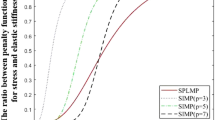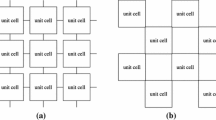Abstract
A new method is proposed for simultaneous optimization of shape, topology and cross section of plane frames. Compliance against specified loads is minimized under constraint on structural volume. Difficulties caused by the melting nodes can be alleviated to some extent by introducing force density as design variables for defining the geometry, where the side constraints are assigned for force density to indirectly avoid the existence of extremely short members. Force density method is applied to an auxiliary cable-net model with different boundary and loading conditions so that the regularity of force density matrix is ensured by positive force densities. Sensitivity coefficients of the objective and constraint functions with respect to the design variables are also explicitly calculated. After the optimal geometry of the frame is obtained, the topology is further improved by removing the thin members and combining closely spaced nodes. It is demonstrated in the numerical examples of three types of frames that rational geometry and topology can be achieved using the proposed method, and the effect of bending moment on the optimal solution is also discussed.



















Similar content being viewed by others
References
Maxwell JC (1870) On reciprocal figures, frames, and diagrams of forces. Trans R Soc Edinb. https://doi.org/10.1017/S0080456800026351
Michell AGM (1904) The limits of economy of lllaterial in frame-structures. Philos Mag Ser 6(8):589–597. https://doi.org/10.1080/14786440409463229
Bendose MP, Ben-Tal A, Zowe J (1994) Optimization methods for truss geometry and topology design. Struct Optim 7:141–159. https://doi.org/10.1117/12.660870
Stolpe M (2016) Truss optimization with discrete design variables: a critical review. Struct Multidiscip Optim 53:349–374. https://doi.org/10.1007/s00158-015-1333-x
Bendsøe MP, Sigmund O (2003) Topology optimization: theory, methods, and applications. Springer
Ohsaki M (2010) Optimization of finite dimensional structures. CRC Press, Boca Raton
Lewiński T, Sokół T, Graczykowski C (2019) Michell structures. Springer, Berlin
Kirsch U, Taye S (1986) On optimal topology of grillage structures. Eng Comput 1:229–243. https://doi.org/10.1007/BF01200139
Adil B, Cengiz B (2019) Optimal design of truss structures using weighted superposition attraction algorithm. Eng Comput. https://doi.org/10.1007/s00366-019-00744-x
Dorn WS, Gomory RE, Greenberg HJ (1964) Automatic design of optimal structures. J Mech 3:25–52
Topping BHV (1983) Shape optimization of skeletal structures: a review. J Struct Eng 109:1933–1951. https://doi.org/10.1061/(asce)0733-9445(1983)109:8(1933)
Gil L, Andreu A (2001) Shape and cross-section optimization of a truss structure. Comput Struct 79:681–689. https://doi.org/10.1016/S0045-7949(00)00182-6
Lamberti L, Pappalettere C (2003) A numerical code for lay-out optimization of skeletal structures with sequential linear programming. Eng Comput 19:101–129. https://doi.org/10.1007/s00366-003-0258-y
Achtziger W (2007) On simultaneous optimization of truss geometry and topology. Struct Multidiscip Optim 33:285–304. https://doi.org/10.1007/s00158-006-0092-0
Ohsaki M (1998) Simultaneous optimization of topology and geometry of a regular plane truss. Comput Struct 66:69–77. https://doi.org/10.1016/S0045-7949(97)00050-3
Xu G, Wei L (2019) Simultaneous shape and topology optimization of truss under local and global stability constraints. Acta Mech Solida Sin 16(2):95–101
Czarnecki S (2003) Compliance optimization of the truss structures. Comput Assist Mech Eng Sci 10:117–137
Sokół T (2011) A 99 line code for discretized Michell truss optimization written in Mathematica. Struct Multidiscip Optim 43:181–190. https://doi.org/10.1007/s00158-010-0557-z
Schek HJ (1974) The force density method for form finding and computation of general networks. Comput Methods Appl Mech Eng 3:115–134. https://doi.org/10.1016/0045-7825(74)90045-0
Zhang JY, Ohsaki M (2006) Adaptive force density method for form-finding problem of tensegrity structures. Int J Solids Struct 43:5658–5673
Ohsaki M, Hayashi K (2017) Force density method for simultaneous optimization of geometry and topology of trusses. Struct Multidiscip Optim 56:1157–1168. https://doi.org/10.1007/s00158-017-1710-8
Kimura T, Ohsaki M, Yamaoka Y (2019) Shape and topology optimization of latticed shear wall utilising contact to existing frame. J Struct Constr Eng (Trans AIJ) 84:385–391 (in Japanese)
Descamps B, Coelho RF (2014) The nominal force method for truss geometry and topology optimization incorporating stability considerations. Int J Solids Struct 51:2390–2399. https://doi.org/10.1016/j.ijsolstr.2014.03.003
Zienkiewicz OC, Taylor RL, Zhu JZ (2005) The inite element method: its basis and fundamentals, 6th edn. Elsevier, Oxford
Zhang JY, Ohsaki M (2015) Tensegrity structures: form, stability, and symmetry. Springer, Berlin
Kanno Y, Ohsaki M (2003) Minimum principle of complementary energy of cable networks by using second-order cone programming. Int J Solids Struct 40:4437–4460. https://doi.org/10.1016/S0020-7683(03)00215-4
Kirsch U, Bogomolni M, Sheinman I (2007) Eicient structural optimization using reanalysis and sensitivity reanalysis. Eng Comput 23:229–239. https://doi.org/10.1007/s00366-007-0062-1
Ohsaki M, Ikeda K (2010) Stability and optimization of structures: generalized sensitivity analysis. Springer, Sendai
Arora JS, Haug EJ (1979) Methods of design sensitivity analysis in structural optimization. AIAA J 17:970–974. https://doi.org/10.2514/3.61260
Achtziger W (1998) Multiple-load truss topology and sizing optimization: some properties of minimax compliance. J Optim Theory Appl 98:255–280. https://doi.org/10.1023/A:1022637216104
Mathworks (2018) Optimzation toolbox user’s guide R2018a
Acknowledgements
This research is partially supported by China Scholarship Council (File No. 201806050114).
Author information
Authors and Affiliations
Corresponding author
Additional information
Publisher's Note
Springer Nature remains neutral with regard to jurisdictional claims in published maps and institutional affiliations.
Appendix
Appendix
The intermediate solutions in optimization procedure of Example 1 with \( \overline{V} \)= 1 are shown in Figs. 20 and 21 for Cases P and N, respectively. Note that both the results correspond to the best results of problem (20), and the red and blue color of members stand for positive and negative member forces, respectively. The figure at the top-right of Fig. 21 is trimmed to be consistent with the others, although some of the nodes and members are cut off.
As seen from Figs. 20 and 21, in Case N the structure undergoes drastic variation at the beginning mainly due to the change of signs of the force; on the other hand, iteration in optimization procedure with Case P has “smoother” shape variation leading to a monotonic convergence to the solution.
Rights and permissions
About this article
Cite this article
Shen, W., Ohsaki, M. Geometry and topology optimization of plane frames for compliance minimization using force density method for geometry model. Engineering with Computers 37, 2029–2046 (2021). https://doi.org/10.1007/s00366-019-00923-w
Received:
Accepted:
Published:
Issue Date:
DOI: https://doi.org/10.1007/s00366-019-00923-w






